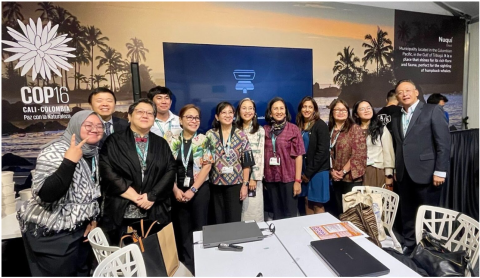ASEAN bares plan for nature at UN Biodiversity Conference in Colombia
CALI, Colombia — The 10-member states of the Association of Southeast Asian Nations (ASEAN) share the region’s biodiversity priorities and targets in an event called “Road to Living in Harmony with Nature: The ASEAN Way” on the sidelines of the UN Biodiversity Conference on 28 October.
This year’s UN conference, officially known as the 16th meeting of the Conference of the Parties to the Convention on Biological Diversity (COP 16), is participated in by key players from the environment sector from over 190 countries to discuss issues and plans to address pressing global issues such as biodiversity loss, climate change, and pollution, among others. These actions are carefully guided by the Kunming-Montreal Global Biodiversity Framework, a set of 23 targets to reduce threats to biodiversity; meet people’s needs through sustainable use and benefit-sharing; and utilise tools and solutions for implementation and mainstreaming.
To strategically contribute to the realisation of this global biodiversity framework, the ASEAN Member States, with support from the ASEAN Secretariat and the ASEAN Centre for Biodiversity (ACB), developed the region’s biodiversity strategy and action plan or the ASEAN Biodiversity Plan. This will guarantee complementarity with the National Biodiversity Strategies and Action Plans of the member states, as well as synergies between the global biodiversity targets and ASEAN’s vision and priorities necessitating collective regional actions.
“We believe that the ASEAN way for living in harmony with nature will not only benefit the region but also inspire other regions,” said Ms. Astrid Schomaker, executive secretary of the UN Convention on Biological Diversity. “The ACB was recently selected as one of the regional centres of scientific and technical cooperation that will help boost and accelerate the implementation of the KMGBF by providing tailored backstopping to countries in the region they cover. Thank you, ACB, for stepping up action and for setting an excellent example of regional cooperation,” she added.
The side event gathered representatives from all stakeholders of ASEAN biodiversity—governments, the private sector, youth, indigenous peoples and local communities (IPLCs), academia, scientific communities, and non-government organisations, to share their experiences and ideas on how to contribute to both regional and global biodiversity frameworks.
Environment officials from the Philippines, Indonesia, Lao PDR, and Thailand presented updates and challenges on the development of their National Biodiversity Strategies and Action Plans (NBSAPs).
Youth leaders representing the ASEAN Youth Biodiversity Programme (AYBP) of the ACB likewise shared the results and recommendations on how to empower the youth further based on the results of a mapping study documenting ASEAN youth’s contributions to the achievement of global biodiversity goals and targets. This study was conducted by the ACB, in collaboration with the Global Youth Biodiversity Network Southeast Asia, and with support from the KfW Development Bank and the Hanns Seidel Stiftung.
The Indigenous and Community Conserved Areas (ICCA) Consortium Southeast Asia, represented by Dr. June Rubis, shared views on the rights of IPLCs, and their possible contributions to biodiversity conservation. She expressed their willingness to contribute to the implementation of the ASEAN Biodiversity Plan.
Ms. June Cheryl Cabal-Revilla of the Metro Pacific Investments Corporation, an investment-holding company in the Philippines also shared their efforts to strike the balance between infrastructure development and sustainability. Revilla shared some of their means to integrate environmental stewardship into business such as investing more financial resources in designing, building, and operating infrastructure with the least environmental and social disruptions; creating vertical gardens in major highways; and greening expressways in the Philippines.
“While essential frameworks are in place to help us ‘make peace with nature,’ the greater challenge is now in implementing these plans,” said Dr. Theresa Mundita Lim, executive director of the ACB. “Our success now lies in the power of inclusive and collective action – a whole-of-society approach so that we can continue on our way of economic development without sacrificing environmental sustainability. This is the ASEAN way and we would like everyone to be a part of it,” she added.
Malaysia likewise shared their priorities as the incoming chair of ASEAN in 2025. H.E. Nik Nazmi bin Nik Ahmad, Minister of Natural Resources and Environmental Sustainability shared that under the theme “Inclusivity and Sustainability,” Malaysia will push for cross-border conservation, combatting wildlife trafficking, and climate adaptation and resilience.

